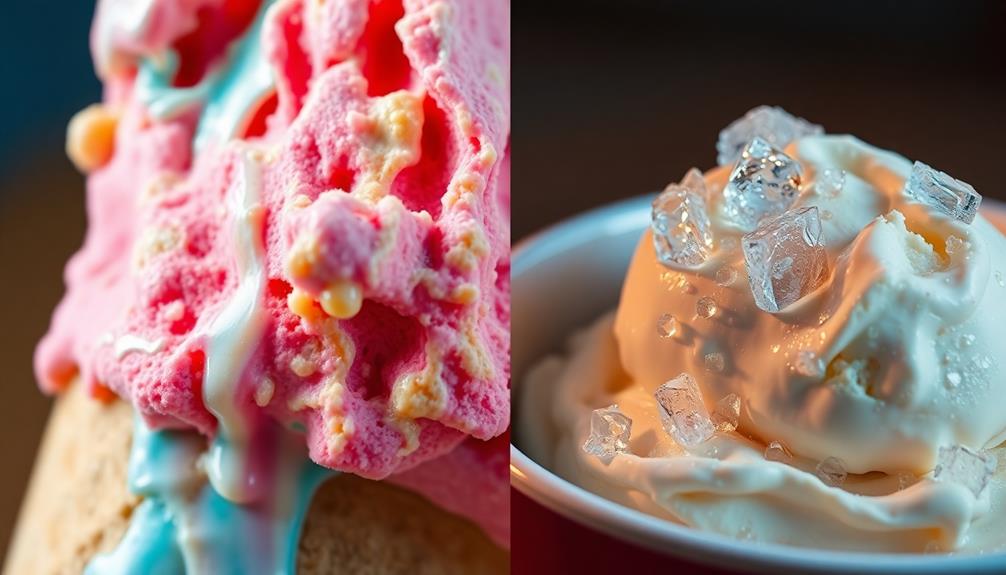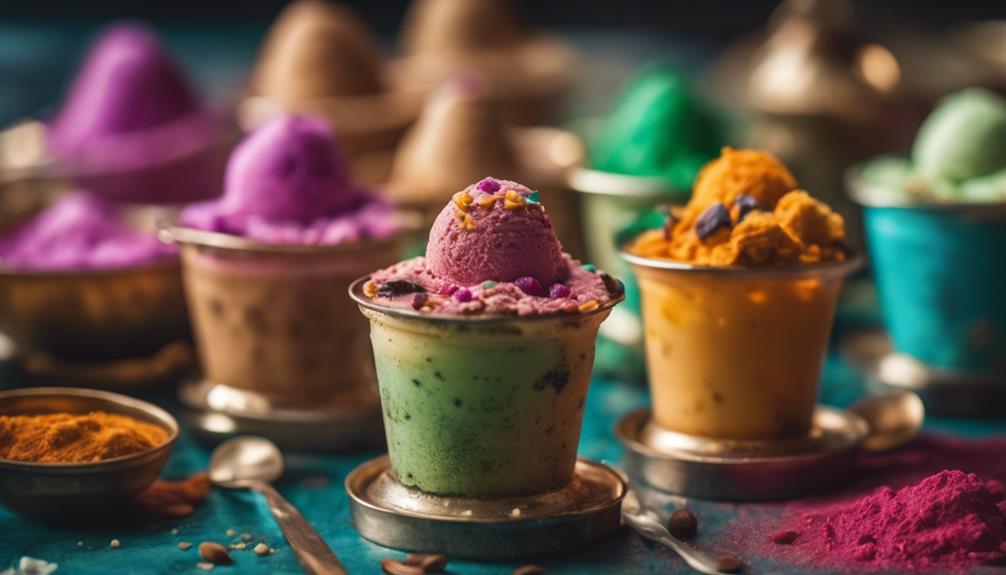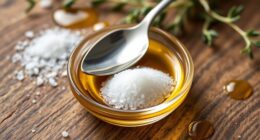Temperature considerably affects your ice cream's structure and taste. When stored too warm, larger ice crystals form, leading to a grainy texture that spoils the experience. Ideal temperatures, between -28.9 °C and -20 °C, help maintain smaller ice crystals and a creamy consistency. This creates a smoother mouthfeel that enhances flavor release, making your ice cream taste sweeter and less bitter. Proper storage not only preserves the creaminess but also keeps flavor intensity intact. Curious about how different techniques can further enhance these qualities? Keep exploring to discover even more about this delightful treat!
Key Takeaways
- The ideal storage temperature for ice cream is between -28.9 °C and -20 °C to maintain a smooth, creamy texture.
- Lower temperatures, such as -70 °C, minimize ice crystal growth, preserving the creaminess and overall quality of ice cream.
- Ice crystal size significantly impacts texture; larger crystals lead to graininess, while smaller crystals provide a smooth mouthfeel.
- Warmer temperatures around -6 °C enhance sweetness perception and flavor release, improving the overall taste experience.
- Consistent storage conditions are essential, as temperature fluctuations can degrade flavor intensity and texture integrity.
Importance of Temperature in Ice Cream
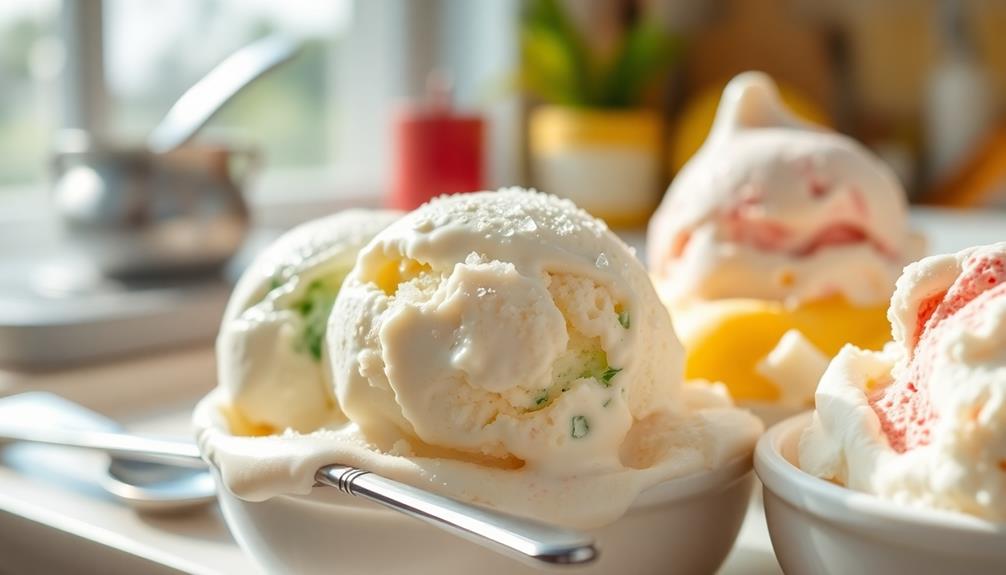
When you consider the quality of ice cream, temperature plays an essential role in determining its texture and flavor. The freezing point of ice cream is influenced by dissolved solutes, primarily sugar, which typically results in a freezing temperature around -3 °C (27 °F). This freezing point depression affects ice crystal size, important for achieving a smooth texture.
If you store ice cream at -18 °C, ice crystals can grow considerably over time, leading to a grainy texture. Conversely, maintaining lower temperatures, like -70 °C, minimizes ice crystal growth, preserving a creamy consistency.
Moreover, temperature impacts air cell dynamics. At higher storage temperatures, air cell size increases, which can alter the mouthfeel of your ice cream.
To guarantee ideal quality attributes—such as texture, flavor intensity, and melting resistance—it's essential to keep your ice cream in controlled storage conditions between -28.9 °C and -20 °C. Higher temperatures can degrade the quality, producing larger ice crystals and diminishing flavor.
Therefore, understanding the importance of temperature in ice cream is key to enjoying a delightful treat that meets your expectations.
Structure of Ice Cream Explained
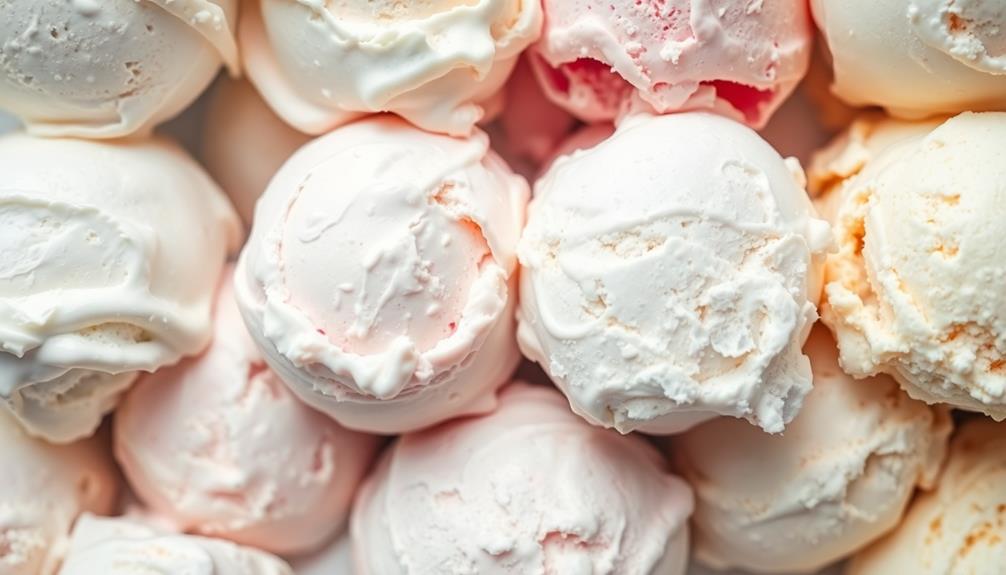
Understanding the significance of temperature in ice cream naturally leads to examining its structure. Ice cream is a complex blend of air cells, ice crystals, and fat globules dispersed in a continuous unfrozen solution. This intricate structure considerably influences its texture and mouthfeel.
Ideally, the size distribution of ice crystals should range between 10-20 µm; larger ice crystals can create a coarse or icy texture that detracts from the experience.
High fat content, usually around 23%, is crucial for achieving that smooth, creamy texture you love. Coupled with approximately 11% milk solids-not-fat, this combination guarantees peak stability.
For homemade ice cream, a total solids content of about 55% is recommended, with around 4% protein to enhance stability further.
The size and distribution of air cells, fat globules, and ice crystals greatly affect the melting rate of the ice cream. Smaller air cells and higher fat content contribute to a slower melting process, allowing you to savor each bite longer.
Flavor Release at Different Temperatures
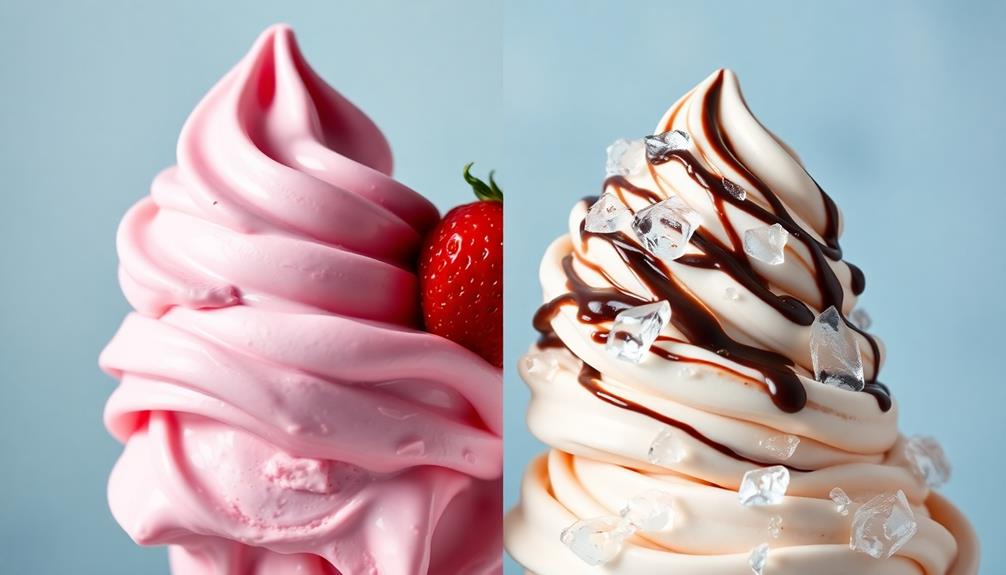
When you enjoy ice cream, the temperature plays a key role in how you perceive its flavors.
At warmer temperatures, you might notice that sweetness stands out more, while bitter notes fade away.
This dynamic interaction between temperature and flavor release can greatly enhance your overall tasting experience.
Temperature and Flavor Perception
At slightly elevated temperatures, ice cream transforms into a canvas for enhanced flavor perception. When you enjoy your ice cream just above its freezing point, around -6 °C, you'll notice an increase in sweetness and a decrease in bitterness. This ideal temperature promotes better flavor release and mouthfeel, making each bite more enjoyable.
However, if your ice cream is stored at improper temperatures, you may encounter flavor intensity loss. Temperature fluctuations during storage can lead to ice crystal growth, negatively affecting both the texture and taste. Higher temperatures can compromise the integrity of volatile flavor compounds, diminishing the overall experience.
To fully savor the taste of your favorite treat, aim for that perfect serving temperature. You'll find that the sweetness shines through, turning each scoop into a delightful experience.
Remember, the right storage temperature is essential to preserving those delightful flavors. By understanding how temperature impacts flavor perception, you can make the most of your ice cream, ensuring every bite is packed with optimal flavor and a creamy mouthfeel.
Enjoy your ice cream at the right temperature, and you won't be disappointed!
Cold vs. Warm Release
Ice cream's flavor release varies dramatically between cold and warm temperatures, directly impacting your tasting experience. When served cold, ice cream tends to mute flavors, leading to a less intense taste.
However, as it warms slightly, the temperature enhances sweetness and reduces bitterness, thanks to the activation of TRPM5 channels. The ideal flavor release occurs around -6 °C, where you can enjoy a balance of coldness and flavor intensity.
As ice cream warms, volatile compounds become more accessible, allowing the aroma and flavor to reach your olfactory receptors more effectively. This increased accessibility considerably enhances your overall flavor perception.
Additionally, higher temperatures can lead to greater melting resistance, creating a smoother texture that further aids in flavor release.
Ice Crystal Formation and Texture
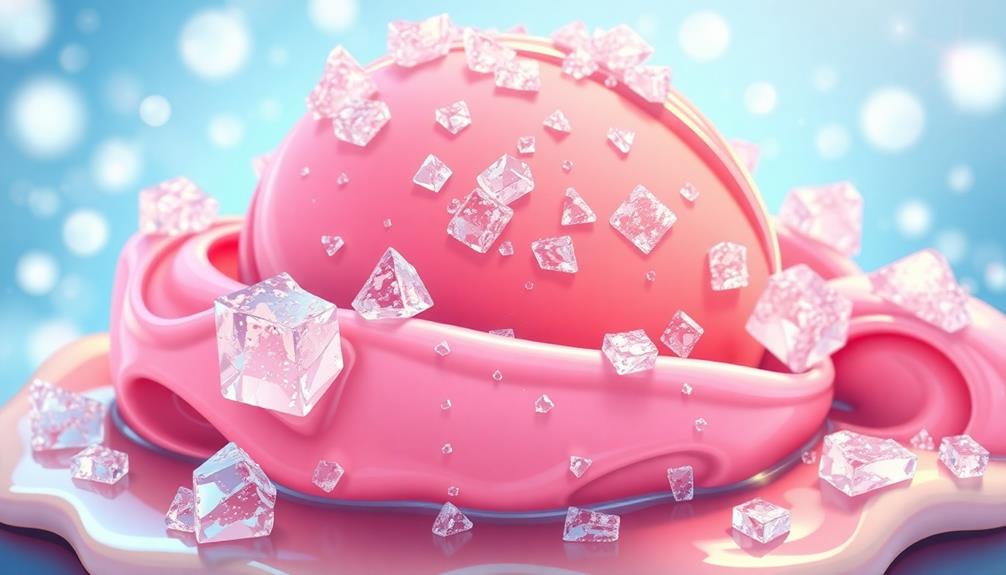
Achieving a smooth texture in ice cream relies heavily on the size of ice crystals, which should ideally measure between 10 and 20 µm. When ice crystal formation leads to larger ice crystals, you'll notice a coarse or icy mouthfeel that detracts from the overall experience.
Prolonged storage, especially at higher temperatures, can cause these ice crystals to grow considerably, sometimes reaching sizes of 100.1 µm after just 52 weeks at -18°C.
To maintain a desirable texture, rapid freezing techniques are essential. They help minimize ice recrystallization, resulting in smaller ice crystals that contribute to a smoother finish. Additionally, the inclusion of stabilizers plays a vital role in controlling ice crystal size, preventing the formation of large crystals while enhancing creaminess.
Full-fat ice creams tend to have smaller ice crystals due to their higher total solids content, which correlates strongly with a creamier texture compared to low-fat variants that often struggle with larger ice crystals.
Role of Ingredients in Texture

The ingredients you choose play an essential role in determining ice cream's texture. A well-balanced formula not only enhances creaminess but also affects how your ice cream feels and melts in your mouth.
It's crucial to highlight that excessive consumption of ice cream can lead to health issues, so understanding these components can help you create a treat that's both enjoyable and mindful of health considerations, such as ice cream health impacts.
Here are three key components to evaluate:
- Fat: Ideal fat content of 10-20% contributes considerably to a creamy texture, while higher levels can enhance mouthfeel.
- Milk Solids-Not-Fat (MSNF): Aim for around 11% MSNF to achieve partial coalescence, stabilizing the emulsion and improving texture.
- Stabilizers and Emulsifiers: Ingredients like guar gum and lecithin help prevent large ice crystals, ensuring a smooth consistency. They also create smaller air cells, enhancing mouthfeel and melting resistance.
The balance of sweetness from sugar influences not just flavor but also the melting rate, contributing to a softer texture.
With the right combination of these ingredients, you can achieve a delightful ice cream that's not only creamy but also has a velvety texture that melts perfectly in your mouth.
Impact of Storage Conditions
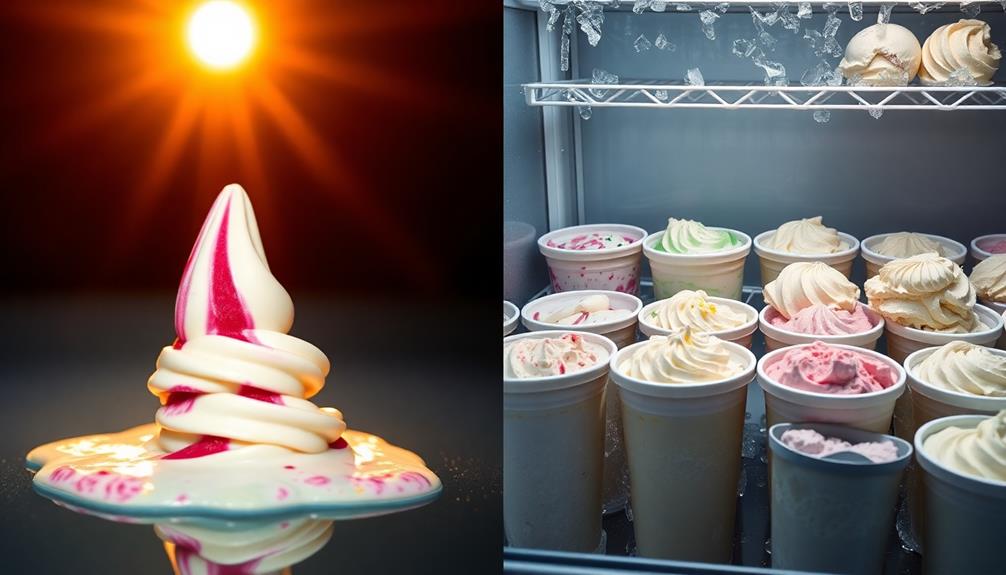
When you store ice cream, the temperature plays an essential role in maintaining its quality.
Ideally, you want to keep it at -50°C to prevent ice crystal formation, which can ruin the texture. Staying within the recommended range of -28.9°C to -20°C helps guarantee a smooth, creamy treat that melts just right.
Ideal Storage Temperatures
Maintaining ice cream at the ideal storage temperatures is essential for preserving its quality and texture. The best temperature for ice cream storage is around -50°C, while industry standards typically range from -28.9°C to -20°C. Sticking to these guidelines helps minimize ice crystal growth, ensuring your ice cream retains its smooth texture and rich creaminess.
Here are three key aspects to take into account for quality preservation:
- Temperature Consistency: Fluctuations in storage temperature can lead to degradation in flavor intensity and affect melting resistance. Keeping a steady low temperature is vital.
- Impact of Higher Temperatures: Storing ice cream at warmer temperatures, such as -18°C, can increase ice crystal size considerably over time, resulting in a grainy texture and quicker melting rates.
- Benefits of Lower Temperatures: Lower storage temperatures, like -70°C, effectively minimize ice crystal growth, allowing for a smoother texture and enhanced overall quality.
Ice Crystal Formation
Ice crystal formation plays an essential role in determining the texture and overall quality of ice cream. When you store ice cream at higher storage temperatures, the ice crystal size considerably increases. For instance, at -18°C, ice crystals can grow from 40.3 µm to 100.1 µm after 52 weeks, resulting in a grainy texture that negatively impacts mouthfeel.
Conversely, lower storage temperatures, such as -70°C, minimize ice crystal growth, preserving a smoother texture with only slight increases in size.
The initial formation of ice crystals is influenced by the freezing point; improper storage conditions lead to larger ice crystals, further compromising the quality of ice cream. Over time, especially during prolonged storage, ice crystal growth becomes more pronounced, particularly in low-fat varieties that already have a less creamy texture.
To combat this issue, stabilizers are crucial. By effectively using stabilizers, you can limit the growth of large ice crystals, ensuring a more desirable texture and maintaining the ice cream's quality.
Keeping these factors in mind will help you enjoy a consistently smooth and creamy product.
Innovations in Ice Cream Production

In the domain of ice cream production, innovations are transforming the way this beloved treat is made and enjoyed.
These advancements not only enhance the flavor but also greatly improve the ice cream structure and texture. You'll find that several techniques stand out:
- Rapid Freezing with Liquid Nitrogen: This method creates small ice crystals, leading to a smoother and creamier texture compared to traditional freezing methods.
- Advanced Aeration Techniques: Companies like Smitten Ice Cream are utilizing advanced technologies to incorporate air more uniformly, enhancing the texture and mouthfeel of their products.
- Incorporation of Dietary Fibers: Adding dietary fibers improves viscosity and stability, which can help reduce melting rates during storage, ensuring your ice cream stays delicious longer.
These innovations in ice cream production allow you to enjoy a treat that's not just rich in flavor but also boasts an improved texture and consistent quality.
Fun Facts About Ice Cream Temperature
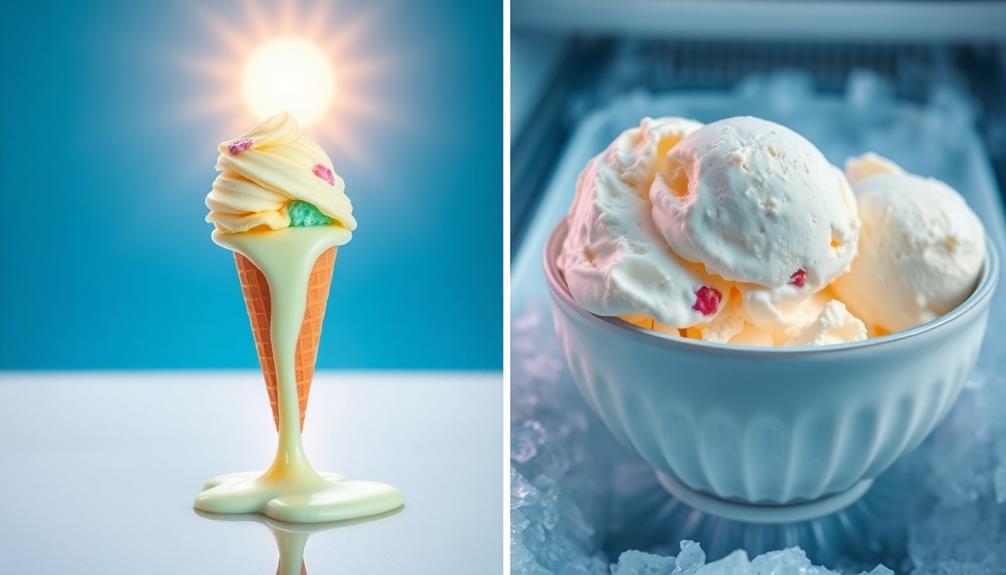
Did you know that the temperature at which ice cream is frozen plays a crucial role in its texture and flavor? Ice cream is typically frozen at around -3°C (27°F), a critical temperature that controls ice crystal and air cell size.
If the temperature is too high, you'll notice larger ice crystals forming, leading to a grainy texture and diminished quality. To maintain that rich creaminess, the ideal storage temperature is around -50°C, with industry standards ranging from -28.9°C to -20°C.
Have you ever experienced brain freeze? This common phenomenon happens when you consume ice cream too quickly, causing cold contact with the roof of your mouth. It leads to blood vessel dilation and that sudden headache we all dread.
Did you know that rapid freezing techniques, like those using liquid nitrogen, create smaller ice crystals? This method enhances the smoothness of your ice cream and improves its texture, making every bite a delight.
Also, the amount of milk fat in your favorite treat contributes to its overall creaminess. So, next time you indulge in ice cream, remember how temperature plays a crucial role in your delicious experience!
Frequently Asked Questions
How Does Temperature Affect Ice Cream?
Temperature affects ice cream by determining its texture and melting rate. If it's too warm, you'll notice larger ice crystals, leading to a grainy feel. Cooler temperatures preserve creaminess and enhance sweetness for a better taste experience.
What Affects the Taste of Ice Cream?
Imagine a canvas; the taste of ice cream is painted by sweetness, fat content, and flavoring agents. You'll savor creaminess and aroma as they dance on your palate, creating a delightful symphony of flavors.
What Temperature Does Ice Cream Taste Best?
Ice cream tastes best between -10°C and -15°C. At this range, flavors pop and textures are creamy. If it's too cold or warm, you might miss out on the full experience. Enjoy it just right!
How Does Temperature Affect Taste?
Temperature affects taste by altering your perception of flavors. Warmer temperatures often enhance sweetness while diminishing bitterness, leading to a more enjoyable experience. You'll notice richer aromas and improved mouthfeel when savoring food at ideal temperatures.
Conclusion
So, next time you scoop up that creamy delight, remember how temperature plays an essential role in its structure and flavor. It's funny, isn't it? A simple change in temperature can transform your favorite treat from a solid block to a velvety masterpiece, revealing hidden flavors and textures. Just like life, ice cream teaches us that the right conditions can bring out the best in us. Enjoy every bite, and appreciate the science behind your sweet indulgence!
